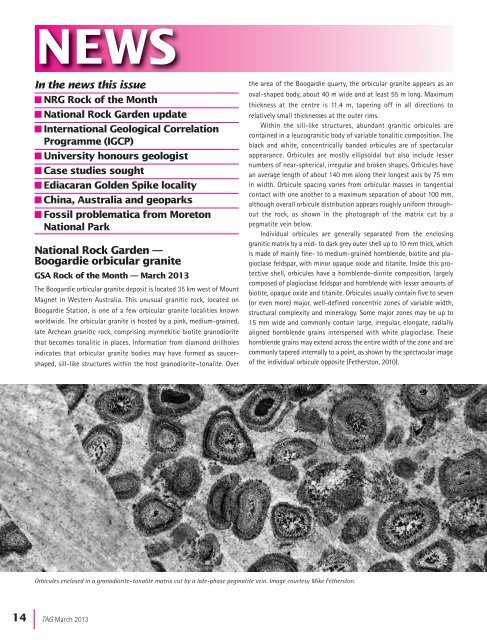TAG 166 - Geological Society of Australia
TAG 166 - Geological Society of Australia
TAG 166 - Geological Society of Australia
You also want an ePaper? Increase the reach of your titles
YUMPU automatically turns print PDFs into web optimized ePapers that Google loves.
NEWSIn the news this issuen NRG Rock <strong>of</strong> the Monthn National Rock Garden updaten International <strong>Geological</strong> Correlationn Programme (IGCP)n University honours geologistn Case studies soughtn Ediacaran Golden Spike localityn China, <strong>Australia</strong> and geoparksn Fossil problematica from Moretonn National ParkNational Rock Garden —Boogardie orbicular graniteGSA Rock <strong>of</strong> the Month — March 2013The Boogardie orbicular granite deposit is located 35 km west <strong>of</strong> MountMagnet in Western <strong>Australia</strong>. This unusual granitic rock, located onBoogardie Station, is one <strong>of</strong> a few orbicular granite localities knownworldwide. The orbicular granite is hosted by a pink, medium-grained,late Archean granitic rock, comprising myrmekitic biotite granodioritethat becomes tonalitic in places. Information from diamond drillholesindicates that orbicular granite bodies may have formed as saucershaped,sill-like structures within the host granodiorite–tonalite. Overthe area <strong>of</strong> the Boogardie quarry, the orbicular granite appears as anoval-shaped body, about 40 m wide and at least 55 m long. Maximumthickness at the centre is 11.4 m, tapering <strong>of</strong>f in all directions torelatively small thicknesses at the outer rims.Within the sill-like structures, abundant granitic orbicules arecontained in a leucogranitic body <strong>of</strong> variable tonalitic composition. Theblack and white, concentrically banded orbicules are <strong>of</strong> spectacularappearance. Orbicules are mostly ellipsoidal but also include lessernumbers <strong>of</strong> near-spherical, irregular and broken shapes. Orbicules havean average length <strong>of</strong> about 140 mm along their longest axis by 75 mmin width. Orbicule spacing varies from orbicular masses in tangentialcontact with one another to a maximum separation <strong>of</strong> about 100 mm,although overall orbicule distribution appears roughly uniform throughoutthe rock, as shown in the photograph <strong>of</strong> the matrix cut by apegmatite vein below.Individual orbicules are generally separated from the enclosinggranitic matrix by a mid- to dark grey outer shell up to 10 mm thick, whichis made <strong>of</strong> mainly fine- to medium-grained hornblende, biotite and plagioclasefeldspar, with minor opaque oxide and titanite. Inside this protectiveshell, orbicules have a hornblende-diorite composition, largelycomposed <strong>of</strong> plagioclase feldspar and hornblende with lesser amounts <strong>of</strong>biotite, opaque oxide and titanite. Orbicules usually contain five to seven(or even more) major, well-defined concentric zones <strong>of</strong> variable width,structural complexity and mineralogy. Some major zones may be up to15 mm wide and commonly contain large, irregular, elongate, radiallyaligned hornblende grains interspersed with white plagioclase. Thesehornblende grains may extend across the entire width <strong>of</strong> the zone and arecommonly tapered internally to a point, as shown by the spectacular image<strong>of</strong> the individual orbicule opposite (Fetherston, 2010).Orbicules enclosed in a granodiorite–tonalite matrix cut by a late-phase pegmatite vein. Image courtesy Mike Fetherston.14 |<strong>TAG</strong> March 2013
















